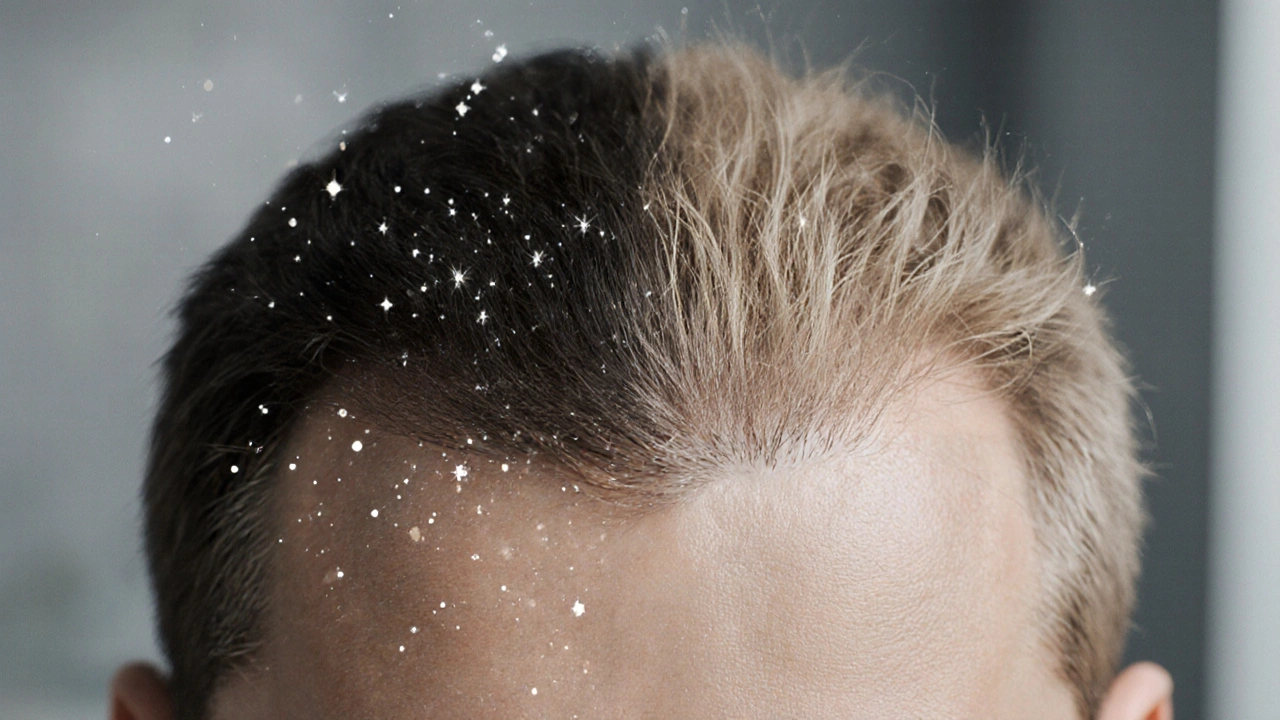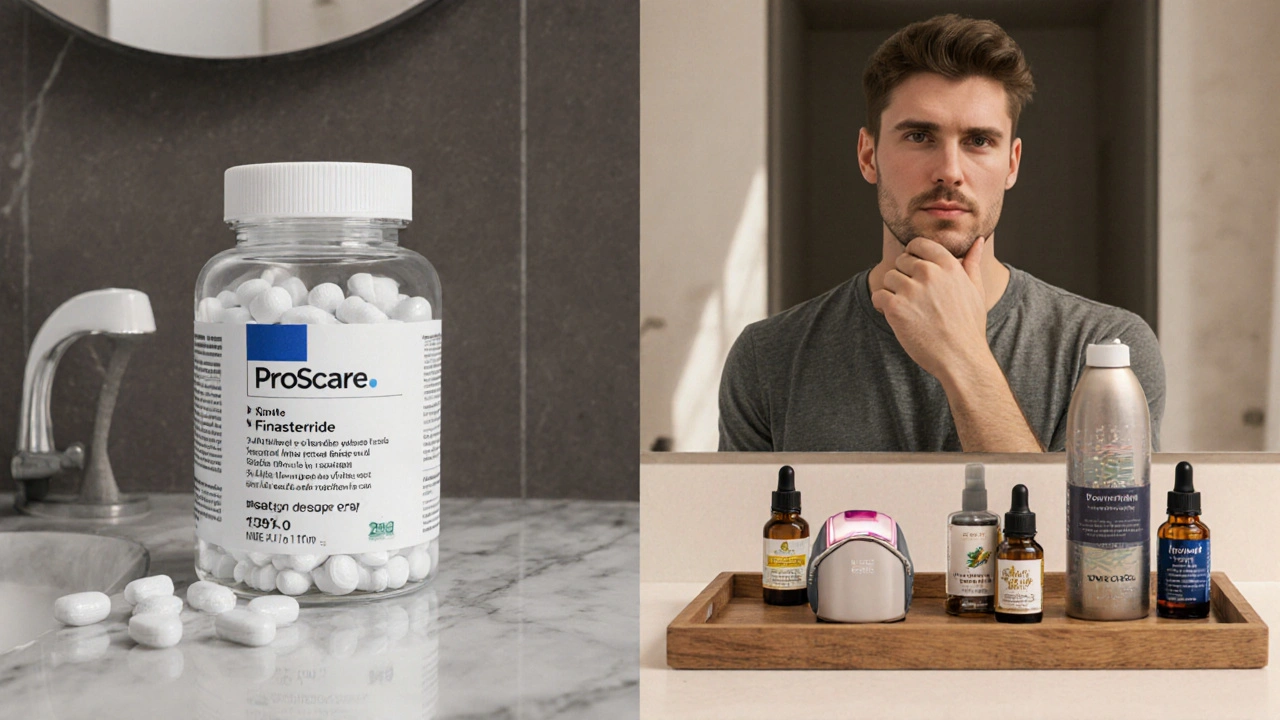Proscare Hair Growth Estimator
Estimate Potential Hair Growth With Proscare
Enter your details below to estimate potential hair regrowth over time with Proscare (Finasteride).
Proscare (Finasteride 1mg tablet for male pattern hair loss) is a prescription medication that blocks the conversion of testosterone to dihydrotestosterone (DHT). DHT is the main hormone that shrinks hair follicles on the scalp, leading to thinning and eventual baldness. By keeping DHT levels low, Proscare can slow or even reverse hair loss in many men.
TL;DR - Quick Takeaways
- Proscare (Finasteride) is the most clinically proven oral treatment for male pattern baldness.
- It works by inhibiting the enzyme 5‑alpha‑reductase, lowering scalp DHT by ~70%.
- Common side effects include reduced libido, erectile changes, and rare mood shifts.
- Top alternatives include Minoxidil, Dutasteride, PRP therapy, low‑level laser devices, and plant‑based supplements.
- Choosing the right option depends on budget, tolerance for medication, and how quickly you want results.
What Is Proscare (Finasteride) and How Does It Work?
Finasteride, sold under the brand name Proscare in NewZealand, belongs to the class of 5‑alpha‑reductase inhibitors. The drug selectively targets the typeII isoform of the enzyme, which is responsible for converting testosterone into the more potent DHT in the scalp. Lower DHT means less follicle miniaturization, allowing existing hairs to stay thicker for longer.
Clinical trials show that about 65% of men who take 1mg daily experience either a halt in hair loss or measurable regrowth after 12months. The average gain is roughly 10-15% increase in hair count compared with baseline. Results are typically visible after 3-4months, but maximum benefit appears around the one‑year mark.
Safety Profile - Benefits vs. Risks
Most users tolerate Proscare well. The most frequently reported side effects are mild and reversible:
- Decreased libido - reported by ~2% of users.
- Erectile dysfunction - ~1%.
- Reduced ejaculate volume - ~1.5%.
Serious adverse events, such as persistent sexual dysfunction or mood disorders, are rare (<0.1%). The drug is not approved for use in women or children because DHT is essential for fetal development.
Cost, Accessibility, and Prescription Requirements
In NewZealand, Proscare costs about NZ$45 for a 30‑day supply, which translates to roughly NZ$540 per year. A private prescription is required, but most general practitioners are familiar with the medication and can issue it after a brief assessment. Insurance coverage varies; some health funds reimburse a portion if hair loss is deemed a medical condition.

Top Alternatives to Proscare
When you start researching hair‑loss solutions, you’ll encounter several options that differ in mechanism, cost, and convenience. Below is a snapshot of the most common alternatives.
- Minoxidil - a topical vasodilator applied twice daily.
- Dutasteride - a dual 5‑alpha‑reductase inhibitor (typeI+II).
- Platelet‑Rich Plasma (PRP) therapy - autologous injections that stimulate follicle activity.
- Low‑Level Laser Therapy (LLLT) - devices that emit red light to improve cellular metabolism.
- Saw palmetto - a botanical extract believed to modestly block DHT.
Side‑by‑Side Comparison Table
| Attribute | Proscare (Finasteride) | Minoxidil 5% | Dutasteride | PRP Therapy | LLLT Device |
|---|---|---|---|---|---|
| Mechanism | 5‑alpha‑reductase typeII inhibition | Vasodilation & follicle stimulation | 5‑alpha‑reductase typeI+II inhibition | Growth‑factor release from platelets | Photobiomodulation (red light) |
| Typical Dose / Frequency | 1mg oral daily | 2ml topical twice daily | 0.5mg oral daily | 3‑4 sessions per month | 15‑20min scalp exposure 3‑4×/week |
| Average Hair‑Count Change (12mo) | +10% to +15% | +5% to +8% | +12% to +18% | +7% to +12% | +5% to +10% |
| Common Side Effects | Sexual dysfunction, mood changes | Scalp irritation, itching | Similar to Finasteride, slightly higher sexual side‑effects | Minor bruising, mild pain | Eye strain (rare), temporary redness |
| Annual Cost (NZ$) | ~540 | ~250 | ~650 | ~1,200 (6‑8 sessions) | ~800 (device purchase) |
| Prescription Needed? | Yes | No (OTC) | Yes | No (administered by clinician) | No |
How to Choose the Right Option for You
Deciding between Proscare and its alternatives isn’t just about price. Consider the following decision matrix:
- Speed of results: Oral inhibitors (Finasteride, Dutasteride) usually show change within 3-4months, while topical Minoxidil can take 6months.
- Tolerance for medication: If you’re hesitant about sexual side effects, a topical (Minoxidil) or device‑based (LLLT) approach may feel safer.
- Budget constraints: Minoxidil is the most affordable OTC option. PRP and laser devices have higher upfront costs but no ongoing pharmacy fees.
- Medical supervision: Finasteride and Dutasteride require a doctor’s prescription, which also provides monitoring for rare side effects.
- Long‑term commitment: All proven treatments need continuous use. Stopping Finasteride or Minoxidil usually reverses gains within months.
For many men, a combination works best-Finasteride to address the hormonal cause, plus Minoxidil to boost follicle density. If you’re allergic to oral meds or prefer a “drug‑free” plan, LLLT or PRP can supplement a low‑dose supplement like Sawpalmetto.
Practical Tips to Maximize Any Treatment
- Take Finasteride at the same time each day to maintain steady blood levels.
- Apply Minoxidil to a clean, dry scalp; allow it to absorb fully before using styling products.
- Schedule PRP sessions 4-6weeks apart for the first three treatments, then maintain with quarterly boosters.
- When using LLLT, keep the device at the recommended distance (usually a few centimeters) to avoid overheating.
- Pair any regimen with a balanced diet rich in zinc, biotin, and omega‑3 fatty acids to support keratin production.
Common Myths About Finasteride and Alternatives
Myth 1: “Finasteride will make you permanently sterile.” - The drug can lower sperm count temporarily, but fertility generally returns after stopping the medication.
Myth 2: “Natural supplements work as fast as prescription meds.” - Plant extracts may provide modest DHT reduction, but clinical evidence shows slower and less dramatic results.
Myth 3: “If a product is OTC, it’s always safer.” - Minoxidil is safe for most, yet improper application can cause scalp irritation that mimics dermatitis.

Frequently Asked Questions
Can women use Proscare (Finasteride) for hair loss?
Finasteride is not recommended for women, especially those who are pregnant or may become pregnant, because it can cause birth defects. Women seeking hair‑loss treatment should consider topical Minoxidil or low‑level laser devices instead.
How long does it take to see results with Proscare?
Most men notice a slowdown in shedding after 3months, with visible regrowth appearing between 4 and 6months. Maximum benefit typically shows up after about a year of continuous use.
Is Dutasteride more effective than Finasteride?
Dutasteride blocks both typeI and typeII 5‑alpha‑reductase enzymes, reducing DHT by up to 90% compared with ~70% for Finasteride. Clinical data suggest slightly higher hair‑count gains, but the side‑effect profile is also a bit stronger, especially regarding sexual function.
Do I need to combine Finasteride with Minoxidil?
Combining the two is a common strategy because they work through different pathways-Finasteride lowers DHT, while Minoxidil stimulates follicle blood flow. Many dermatologists recommend using both for optimal coverage, especially in early‑stage thinning.
What are the long‑term risks of taking Finasteride?
Long‑term data up to 10years show that serious adverse events remain rare. Persistent sexual dysfunction (sometimes called post‑finasteride syndrome) is reported in a tiny fraction of users. Regular medical check‑ups can help monitor any emerging issues.
